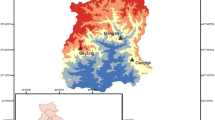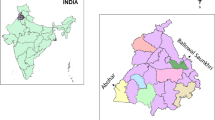Abstract
Adaptation is a key factor for reducing the future vulnerability of climate change impacts on crop production. The objectives of this study were to simulate the climate change effects on growth and grain yield of maize (Zea mays L.) and to evaluate the possibilities of employing various cultivar of maize in three classes (long, medium and short maturity) as an adaptation option for mitigating the climate change impacts on maize production in Khorasan Razavi province of Iran. For this purpose, we employed two types of General Circulation Models (GCMs) and three scenarios (A1B, A2 and B1). Daily climatic parameters as one stochastic growing season for each projection period were generated by Long Ashton Research Station-Weather Generator (LARS−WG). Also, crop growth under projected climate conditions was simulated based on the Cropping System Model (CSM)-CERES-Maize. LARS-WG had appropriate prediction for climatic parameters. The predicted results showed that the day to anthesis (DTA) and anthesis period (AP) of various cultivars of maize were shortened in response to climate change impacts in all scenarios and GCMs models; ranging between 0.5 % to 17.5 % for DTA and 5 % to 33 % for AP. The simulated grain yields of different cultivars was gradually decreased across all the scenarios by 6.4 % to 42.15 % during the future 100 years compared to the present climate conditions. The short and medium season cultivars were faced with the lowest and highest reduction of the traits, respectively. It means that for the short maturing cultivars, the impacts of high temperature stress could be much less compared with medium and long maturity cultivars. Based on our findings, it can be concluded that cultivation of early maturing cultivars of maize can be considered as the effective approach to mitigate the adverse effects of climate.




Similar content being viewed by others
References
Abraha MG, Savage MJ (2006) Potential impacts of climate change on the grain yield of maize for the midlands of KwaZulu-Natal, South Africa. Agric Ecosyst Environ 115:150–160
Anonymous (2013) http://en.wikipedia.org/wiki/Iran
Baker DG, Sharratt BS, Chiang HC et al (1984) Base temperature selection for the prediction of european corn borer instars by the growing degree day method. Agr Forest Meteorol 32:55–60
Bannayan M, Hoogenboom G (2008) Weather Analogue: a tool for real-time prediction of daily weather data realizations based on a modified k-Nearest Neighbor approach. Environ Model Soft 3:703–713
Boote KJ (2011) Improving soybean cultivars for adaptation to climate change and climate variability. In: Yadav SS, Redden RJ, Hatfield JL, Lotze-Campen H, Hall AE (eds) Crop adaptation to climate change. Wiley-Blackwell press, Oxford, ch26
Byjesh K, Kumar SN, Aggarwal PK (2010) Simulating impacts, potential adaptation and vulnerability of maize to climate change in India. Mitig Adapt Strateg Glob Change 15:413–431
Chartzoulakis K, Psarras G (2005) Global change effects on crop photosynthesis and production in Mediterranean: the case of Crete, Greece. Agric Ecosyst Environ 106:147–157
Conover WJ (1980) Practical nonparametric statistics, second ed. Wiley, New York
Darwin R, Kennedy D (2000) Economic effects of CO2 fertilisation of crops: transferring changes in yield into changes in supply. Environ. Modell Assess 5:157–162
Finger R, Hediger W, Schmid S (2011) Irrigation as adaptation strategy to climate change−a biophysical and economic appraisal for Swiss maize production. Clim Chang 105:509–528
Gouachea D, Bris XL, Bogarda M, Deudonc O, Pagéd C, Gatee P (2012) Evaluating agronomic adaptation options to increasing heat stress under climate change during wheat grain filling in France. Euro J Agron 39:62–70
Huang Y, Yu Y, Zhang W et al (2009) Agro-C: A biogeophysical model for simulating the carbon budget of agroecosystems. Agr Forest Meteorl 149:106–129
IPCC (2000) Special Report on Emissions Scenarios (SRES): A special report of working group III of the intergovernmental panel on climate change. Cambridge University Press, Cambridge
IPCC (Intergovernmental Panel on Climate Change) (2007) The physical science basis. Contribution of working group I to the Fourth Assessment Report of the Intergovernmental Panel on Climate Change. Cambridge University Press, Cambridge, p 996, New York, NY, USA
Jones CA, Kiniry JR (1986) CERES-Maize: A simulation model for maize growth and development. Texas A&M University Press, College Station
Jones GP, Thornton PK (2003) The potential impacts of climate change on maize production in Africa andLatin America in 2055. Glob Environ Chang 13:51–59
Jones JW, Hoogenboom G, Porter CH et al (2003) The DSSAT cropping system model. Europ J Agronomy 18:235–265
Kapetanaki G, Rosenzweig C (1997) Impact of climate change on maize yield in central and northern Greece: a simulation study with CERES-Maize. Mitig Adapt Strateg Glob Chang 1:251–271
Khan MS, Coulibaly P, Dibike Y (2006) Uncertainty analysis of statistical downscaling methods. J Hydrol 319:357–382
Loague K, Green RE (1991) Statistical and graphical methods for evaluating solute transport models: overview and application. J Contam Hydrol 7:51–73
Magrin GO, Travasso MI, Daz R, Rodr!ıguez R (1997) Vulnerability of the agricultural systems of Argentina to climate change. Clim Res 9:31–36
MAJ (Ministry of Agriculture of the I.R. of Iran) (2012) Planning and Economics Department, Statistics Bank of Iranian Agriculture, <http://www.maj.ir/english/Statistic/Default.asp?p=statistic>
Mall RK, Lal M, Bhatia VS et al (2004) Mitigating climate change impact on soybean productivity in India: a simulation study. Agr Forest Meteorol 121:113–125
Meza FJ, Silva D, Vigil H (2008) Climate change impacts on irrigated maize in Mediterranean climates: evaluation of double cropping as an emerging adaptation alternative. Agric Syst 98:21–30
Millar N, Robertson GP, Grace PR, Gehl RJ, Hoben JP (2010) Erratum to: Nitrogen fertilizer management for nitrous oxide (N2O) mitigation in intensive corn (Maize) production: an emissions reduction protocol for US Midwest agriculture. Mitig Adapt Strateg Glob Chang 15:411–418
Moradi R, Koocheki A, Nassiri Mahallati M, Mansoori H (2013) Adaptation strategies for maize cultivation under climate change in Iran: irrigation and planting date management. Mitig Adapt Strateg Glob Chang 18:265–284
Nash JE, Sutcliffe JV (1970) River flow forecasting through conceptual models. Part I: a discussion of principles. J Hydro 10:282–290
Nielsen, R. L. 2010. Silk development and emergence in corn. Purdue University. Available at http://www.agry.purdue.edu/ext/corn/news/timeless/silks.html. (accessed at February 2013)
Ozkan B, Akcaoz H (2002) Impacts of climate factors on yields for selected crops in southern Turkey. Mitig Adapt Strat Glob Change 7:367–380
Parry M, Fischer C, Livermore M et al (1999) Climate change and world food security: a new assessment. Global Environ Chang 9:851–867
Prudhomme C, Wilby RL, Crooks S et al (2010) Scenario-neutral approach to climate change impact studies: application to flood risk. J Hydro 390:198–209
Quiring SM, Legates DR (2008) Application of CERES-Maize for within-season prediction of rainfed corn yields in Delaware, USA. Agr Forest Meteorol 148:964–975
Rosenzweig C, Tubiello FN (2007) Adaptation and mitigation strategies in agriculture: an analysis of potential synergies. Mitig Adapt Strat Glob Change 12:855–873
Semenov MK, Brooks RJ (1999) Spatial interpolation of the LARS-WG stochastic weather generator in Great Britain. Clim Res 11:137–148
Semenov MK, Stratonovitch A (2010) Use of multi-model ensembles from global climate models for assessment of climate change impacts. Climatic Res 41:1–14
Smit B, Skinner MW (2002) Adaptation options in agriculture to climate change: a typology. Mitig Adapt Strat Glob Change 7:85–114
Soler CMT, Sentelhas PC, Hoogenboom G (2007) Application of the CSM-CERES-Maize model for planting date evaluation and yield forecasting for maize grown off-season in a subtropical environment. Europ J Agron 27:165–177
Tachie-Obeng E, Akponikp PBI, Adiku S (2013) Considering effective adaptation options to impacts of climate change for maize production in Ghana. Environ Dev 5(2013):131–145
Tao F, Zhang Z (2011) Impacts of climate change as a function of global mean temperature: maize productivity and water use in China. Clim Chang 105:409–432
Tingem M, Rivington M (2009) Rivington M (2009) Adaptation for crop agriculture to climate change in Cameroon: turning on the heat. Mitig Adapt Strateg Glob Chang 14:153–168
Wetterhall F, Bardossy A, Chen D, Halldin S, Ch XU (2009) Statistical downscaling of daily precipitation over Sweden using GCM output. Theor Appl Climatol 96:95–103
Winters P, Murgai R, Janvry A et al (1999) Climate change and agriculture: Effects on developing countries. In: Frisvold G, Kuhn B (eds) Global environmental change and agriculture. Edward Elgar Publishers, Cheltenham
Wolf J, Van Diepen CA (1995) Effects of climate change on grain maize yield potential in the european community. Clim Chang 29:299–331
Yang JC, Zhang JH (2006) Grain filling of cereals under soil drying. New Phytol 169:223–236
Yates DN, Strzepek KM (1998) An assessment of integrated climate change impacts on the agricultural economy of Egypt. Clim Change 38:261–287
Žalud Z, Dubrovský M (2002) Modelling climate change impacts on maize growth and development in the Czech Republic. Theor Appl Climatol 72:85–102
Acknowledgements
The authors acknowledge the financial support of the project by Ferdowsi University of Mashhad, Iran.
Author information
Authors and Affiliations
Corresponding author
Rights and permissions
About this article
Cite this article
Moradi, R., Koocheki, A. & Nassiri Mahallati, M. Adaptation of maize to climate change impacts in Iran. Mitig Adapt Strateg Glob Change 19, 1223–1238 (2014). https://doi.org/10.1007/s11027-013-9470-2
Received:
Accepted:
Published:
Issue Date:
DOI: https://doi.org/10.1007/s11027-013-9470-2




